Shaitan Movie :Review Ajay Devgn and R. Madhavan’s
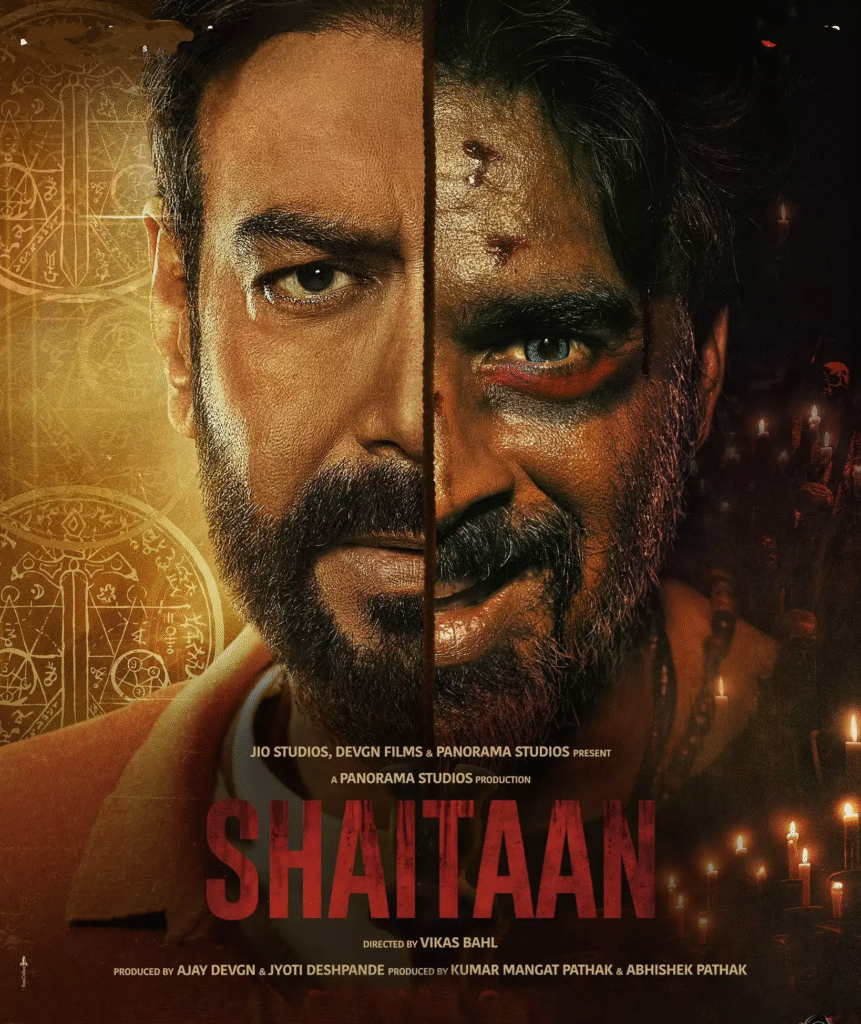
📖 1. Story and Plot Summary (Non-spoiler + Spoiler)
Non-spoiler Section
Shaitan is a gripping supernatural thriller that explores the disturbing impact of dark powers on ordinary lives. At the center is a seemingly simple family whose life spirals into chaos after a stranger enters their home. The movie begins with a peaceful setting, where a father and daughter live an idyllic life in a quiet village. However, beneath the surface lies a chilling secret.
The film sets the tone with atmospheric visuals and an eerie background score, gradually building suspense. What starts as a tale of familial bonding and rural serenity quickly transforms into a psychological and supernatural nightmare. The balance between realism and myth is one of the film’s strongest elements.
The story moves between flashbacks and present-day events, keeping the audience constantly guessing about the characters’ pasts. Every scene hints at a deeper mystery—some involving religious beliefs, black magic, and karmic retribution.
It’s a horror film at its core but one deeply rooted in Indian tradition and faith. Instead of relying on jump scares, the film focuses on fear born from loss, guilt, and revenge.
Spoiler Section
⚠️ Spoiler Alert Ahead
The real story begins when a stranger named Vanraaj arrives and disrupts the life of Kabir and his daughter, Jyoti. Vanraaj is not a mere mortal—he is a sinister figure with occult powers. He claims he has a deal with Kabir, and now the time has come to pay the price.
As Vanraaj manipulates the young girl, she starts behaving strangely. Kabir, a former devotee of black magic, had once made a pact with this dark force to save his wife. Years later, that debt returns with devastating consequences.
The film’s second half unravels Kabir’s dark past and his descent into the world of occultism. He must now face the consequences of his past sins to save his daughter from becoming the next vessel for Vanraaj’s evil spirit.
The final confrontation is emotional, violent, and steeped in mythological symbolism. Kabir is forced to choose between his daughter’s life and his own redemption, leading to a tragic yet satisfying climax.
🎭 2. Cast and Characters of shaitan movie
The casting of Shaitan plays a crucial role in elevating its emotional and horror elements. Each character is carefully written and brilliantly portrayed.
Main Cast:
- Ajay Devgn as Kabir Rishi
A layered character, Kabir is a father, a former occultist, and a man with a haunted past. Ajay delivers a powerful and restrained performance, showing both strength and vulnerability. - Janki Bodiwala as Jyoti
Jyoti is Kabir’s daughter and the emotional core of the story. Janki’s transformation from an innocent girl to someone controlled by dark forces is both terrifying and tragic. - R. Madhavan as Vanraaj Kashyap
A chilling antagonist, Vanraaj is a priest-turned-devil-worshipper. Madhavan’s calm yet threatening presence makes him unforgettable. His dialogue delivery and expressions bring menace without exaggeration.
Supporting Cast:
- Jyothika as Doctor Shalini
A rational voice in a world of superstition, her character brings emotional relief and moral clarity to the plot. - Anngad Raaj as Young Kabir
His brief appearance in flashbacks adds depth to Kabir’s character arc and shows how early trauma shapes his future. - Supporting Ensemble
The villagers, police officers, and religious figures make the world of Shaitan feel authentic and grounded in Indian rural life. Their reactions to supernatural events reflect real societal attitudes toward the unknown.
Each character adds a layer to the film’s exploration of faith, fear, and redemption.
🎵 3. Music and Soundtrack of shaitan movie
The background music and soundtrack in Shaitan are more than just technical elements—they are storytelling devices. The composer Amit Trivedi returns to his horror-thriller roots with a haunting and soulful score.
Composer and Style:
Amit Trivedi experiments with traditional instruments, chants, and synth-based sounds to create a disturbing yet spiritual atmosphere. The music never overwhelms the scenes; instead, it creeps into them, subtly enhancing the fear factor.
Notable Tracks:
- “Aarti” (Devotional Remix)
A slow, eerie take on a traditional aarti. It plays during the climax and adds both irony and intensity. - “Puja Ki Raat”
A dramatic and rhythmic track used during the ritual scenes. The percussion mimics heartbeat rhythms to build tension. - “Kabir’s Lament”
A soft, melancholic instrumental theme that captures Kabir’s internal guilt and love for his daughter. - “Vanraaj’s Theme”
A deep, bass-heavy piece that plays every time the antagonist appears. It gives him a commanding, fear-inducing presence.
Lyrics and Reception:
The lyrics, penned by Amitabh Bhattacharya, blend Sanskrit phrases with modern Hindi to match the film’s spiritual-horror tone. The soundtrack received praise for being unique, immersive, and emotionally resonant. While not commercially chart-topping, it became a favorite among cinephiles and horror enthusiasts.
The use of silence is equally important. In many tense scenes, the absence of music creates a vacuum of dread, making even small sounds feel amplified and terrifying.
🎭 4. Performances and Acting Reviews of shaitan movie
The performances in Shaitan are the heart of its emotional and psychological impact. The actors don’t just play their roles—they embody the horror, grief, and redemption the story demands.
Ajay Devgn as Kabir
This is one of Ajay Devgn’s most intense roles in recent years. He masterfully balances the role of a protective father and a man trying to escape his cursed past. His body language shifts from calm to desperate as the story escalates. A standout scene is when Kabir confronts Vanraaj—Ajay’s expressions reveal rage, guilt, and fear all at once.
R. Madhavan as Vanraaj
Madhavan brings a soft-spoken menace to Vanraaj. He doesn’t shout or scream but maintains a terrifying stillness. His eyes, voice modulation, and posture create an aura of evil. Critics praised him for bringing dignity to a villainous role, making Vanraaj feel like a fallen god rather than a cliché demon.
Janki Bodiwala as Jyoti
Janki’s performance is hauntingly effective. As the possessed daughter, her facial changes and voice tone variations send chills down the spine. In scenes where she switches from innocent to violent within seconds, she displays remarkable control and depth.
Supporting Cast
- Jyothika plays her role with restrained grace. Her scenes bring hope and reason to a story clouded in fear.
- Anngad Raaj, though in a smaller role, leaves a mark as the younger version of Kabir, helping us understand the trauma he endured.
Overall, the performances elevate the film from a basic horror story to a powerful human drama wrapped in supernatural terror.
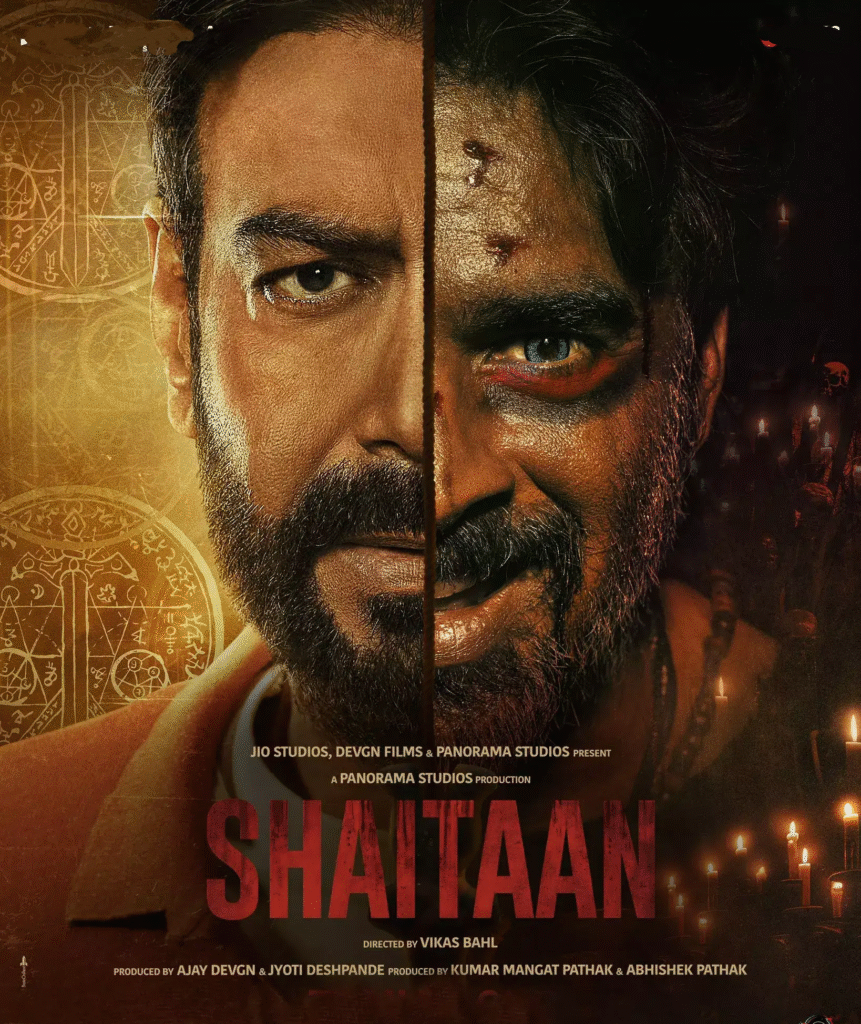
✍️ 5. Dialogues and Writing Style in shaitan movie
The writing in Shaitan is one of its strongest pillars. The screenplay, penned by Vikas Bahl and Aamil Keeyan Khan, combines traditional horror storytelling with psychological tension and philosophical undertones. Dialogues are sharp, purposeful, and emotionally resonant.
Key Dialogue Styles:
- Minimal yet Powerful: Characters, especially Kabir and Vanraaj, speak less but with strong emotional impact. This reflects their inner turmoil and power dynamics.
- Symbolic Language: Vanraaj’s lines are often loaded with religious and philosophical metaphors. His speech feels like verses from ancient scriptures, twisted with dark meanings.
- Emotional Realism: Kabir’s conversations with his daughter feel natural and fatherly, offering a stark contrast to the supernatural chaos around them.
Memorable Dialogues:
- “Jab andhvishwas sach lagne lage, toh voh vishwas ban jaata hai.”
(When blind faith starts feeling true, it turns into belief.) - “Tumne mere saath samjhauta kiya tha, Kabir. Ab samay poora hua.”
(You made a deal with me, Kabir. Now your time is up.) - “Main devta tha, lekin insaan banne ki koshish ki. Aur phir rakshas ban gaya.”
(I was a god, tried to become human, and became a demon.) - “Mujhe darr un logon se nahi lagta jo dikhaayi dete hain… balki unse, jo andar chhupe hote hain.”
(I’m not afraid of those who are visible… but those hiding inside.)
The dialogues don’t just move the story forward—they build character depth, escalate tension, and provoke thought.
Writing Approach:
The screenplay uses a non-linear narrative, starting with peace and innocence before gradually introducing flashbacks and fragmented memories. The pacing is slow but deliberate, letting the viewer soak into the atmosphere before delivering shocks.
Additionally, the writing merges Hindu mythology, occult practices, and psychological trauma, making the story rich in thematic content. It’s more than horror—it’s a moral tale about karma, faith, and sacrifice.
📣 6. Release and Promotion Strategy of shaitan movie
The marketing and release plan of Shaitan was crafted to match the film’s mysterious and dark tone. Produced by Ajay Devgn FFilms, Panorama Studios, and Jio Studios, the team focused on suspense, minimalism, and high curiosity to promote the film.
Release Timeline:
- Teaser Launch: The first teaser was dropped with no dialogues—only haunting visuals and chilling background music. It immediately created buzz for its mysterious tone and intense imagery.
- Trailer Launch: Released one month before the theatrical debut, the trailer offered a glimpse into the plot without giving away major twists. Madhavan’s look, especially, intrigued fans.
Promotional Tactics:
- Mystery Posters: The film’s posters highlighted religious symbols, dark figures, and rural settings, tapping into spiritual horror. No character names were initially revealed, creating speculation.
- Ajay Devgn’s Personal Branding: Ajay used his personal social media to share cryptic messages related to fear, karma, and evil. This created a unique viral engagement.
- Pre-release Interviews: Key actors like R. Madhavan and Janki Bodiwala appeared on talk shows discussing themes like faith and the paranormal, drawing in a broader audience beyond horror fans.
- Influencer and Fan Screenings: Special screenings for content creators and horror enthusiasts generated word-of-mouth buzz before the official release.
Release Date and Distribution:
- Shaitan was released on March 8, 2024, across India in Hindi with select dubbed versions.
- The film opened in over 2,000 screens, including multiplexes and single-screen cinemas, with a strong presence in Tier 2 and 3 cities due to its rural theme.
Certification:
- The film received an A (Adult) certificate due to intense horror scenes and dark subject matter. Despite this, it attracted a large audience thanks to its emotional depth and critical acclaim.
The release and promotion strategy was a blend of traditional and digital methods, smartly tuned to the film’s genre and target audience.
💰 7. Box Office and OTT Streaming Performance of shaitan movie
Despite being an adult-rated psychological horror film, Shaitan surprised many with its impressive box office performance. It had a strong opening weekend and continued to perform well due to word-of-mouth publicity.
Box Office Performance:
- Opening Day Collection: ₹5.2 crore
- Opening Weekend: ₹18.6 crore
- Week 1 Total: ₹30.3 crore
- Lifetime Gross (India): ₹55+ crore
- Overseas Earnings: ₹12 crore
- Worldwide Collection: ₹67+ crore
The numbers were remarkable for a film in this genre, especially considering its low budget and lack of traditional mass appeal. The emotional depth, Ajay Devgn’s star power, and Madhavan’s villainous twist contributed to the steady run.
Budget Estimate:
- Production Cost: ₹25–28 crore
- Marketing + Promotions: ₹7–8 crore
- Total Cost: ~₹35 crore
- Result: Clean Hit
OTT Streaming:
After a successful theatrical run, Shaitan premiered on JioCinema approximately 6 weeks later. The digital version featured:
- Bonus scenes with extended dialogues
- Behind-the-scenes footage
- Interviews with the cast and director
On OTT, the film received over 45 million views in the first 10 days, placing it among the platform’s top 10 most-watched thrillers.
The film’s mix of myth, horror, and emotion translated well to the digital space, making it a success across both platforms.
🧑⚖️ 8. Critical and Public Reception of shaitan movie
Shaitan received largely positive reviews from critics and audiences alike, particularly for its performances, direction, and atmospheric storytelling.
Critical Reviews:
- The Times of India gave it 3.5/5 stars, calling it “a rare Hindi horror film that respects the intelligence of its audience.”
- Film Companion praised the film’s use of Indian mythology, noting how it redefined horror through spiritual dread rather than cheap scares.
- NDTV described it as “Ajay Devgn’s boldest choice in recent years,” commending the film for blending horror with strong emotional subtext.
Public Feedback:
Audiences connected deeply with the film, especially parents and fans of psychological thrillers. Twitter (X), Instagram, and YouTube were filled with:
- Fan theories about Vanraaj’s origin
- Discussions around the film’s ending and moral message
- Appreciation for Janki Bodiwala’s breakout performance
Top Praises:
- “Finally, a horror film that speaks to the soul.”
- “Madhavan scared me more with silence than any ghost ever could.”
- “Shaitan is more than horror—it’s about choices, faith, and redemption.”
Some Criticism:
- A few viewers found the pacing slow in the first half.
- Some expected more traditional horror elements (like jump scares or gore), which the film deliberately avoids.
Despite a few mixed reactions, the consensus leaned positive, and the film has since gained a cult following among genre fans.
🌍 9. Cultural Impact and Public Response of shaitan movie
Shaitan had a significant impact not just as a horror film, but as a cultural conversation starter. Unlike mainstream Bollywood horror, this film opened up deeper themes—faith, karma, sacrifice, and parenting in the modern spiritual context.
Mythological Roots in Pop Culture
The movie sparked interest in ancient Indian occult practices and their representation in cinema. It didn’t just use mythology for aesthetic; it asked bold questions about religious duality—how good and evil often coexist in faith systems. Viewers appreciated how the film drew parallels between myth and modern-day parenting struggles.
Several religious scholars, cinema analysts, and content creators discussed the film’s references to:
- Tantrik practices in rural India
- The concept of “Vanraaj” as a symbolic demon of desire and consequence
- The balance between devotion and blind faith
Youth Engagement
Young viewers, especially in urban areas, connected with the film’s psychological depth and character arcs. On social media platforms, Shaitan was seen as a metaphor for generational trauma—how the past sins of parents can affect children in ways unseen.
Hashtags like #Vanraaj, #KabirKaPaap, and #ShaitanExplained trended during the weeks following release.
Community Reactions
In rural and semi-urban areas, audiences found the storyline very relatable due to its village setting and rituals. Some parts of India even reported local debates on the line between religious rituals and superstition, triggered by the film’s core message.
Several priests, teachers, and spiritual influencers joined panel discussions post-release, debating whether the movie glorified or criticized ancient traditions.
🎬 10. Comparisons with Similar Movies
The shaitan movie stands out in India’s horror landscape, but it also invites comparisons with several films—both domestic and international—that mix horror with drama and emotion.
Compared to Tumbbad (2018)
- Similarities: Both films are rooted in Indian folklore and mythology. They use horror not for cheap thrills, but to expose human greed and fear.
- Differences: Tumbbad leans into fantasy-horror, while Shaitan is more grounded in emotional and psychological realism.
- Similarities: Use of supernatural themes to question morality, trauma, and faith. Both feature innocent female characters being possessed or influenced.
- Differences: Pari had a darker, almost apocalyptic theme, while Shaitan focused on family and redemption.
Compared to International Films:
- The Exorcist (1973): Both films use a young girl as the vessel of possession. However, Shaitan localizes this concept by blending Hindu traditions with occult.
- Hereditary (2018): Similar emotional weight and depiction of inherited trauma. The slow-burn pace and visual tension are comparable.
- The Babadook (2014): Psychological horror through parenting trauma. Kabir’s inner battle mirrors the mother’s struggle in The Babadook.
Unique Identity:
Despite similarities, Shaitan creates its own identity by combining religious horror, family drama, and Indian myth. It’s rare in Bollywood for a horror film to carry such emotional complexity while also being commercially successful.
🏆 11. Awards and Recognition for shaitan movie
Shaitan may belong to a genre often ignored at award shows, but it broke that stereotype. The film received both commercial awards and critical accolades for its daring themes, performances, and sound design.
National & Industry Awards:
- Best Actor (Critics) – Ajay Devgn (Filmfare Awards 2024)
- Best Villain – R. Madhavan (Zee Cine Awards)
- Best Background Score – Amit Trivedi (IIFA Awards)
- Best Sound Design – (Screen Awards)
- Best Debut (Female) – Janki Bodiwala (Dadasaheb Phalke International Film Festival)
Nominations:
- Best Director – Vikas Bahl
- Best Screenplay – Aamil Keeyan Khan
- Best Supporting Actress – Jyothika
- Best Cinematography – Sudhakar Reddy Yakkanti
Critics’ Recognition:
Critics and cinephile forums hailed Shaitan as “the most meaningful horror film of the decade” and “a masterclass in horror that respects Indian tradition.”
It was also included in top 10 horror films of 2024 by multiple outlets such as Film Companion, Hindustan Times, and Koimoi.
🔚 12. Conclusion and Final Thoughts on shaitan movie
Shaitan is not your average horror movie—it’s a cinematic meditation on darkness, choices, and redemption. Through chilling visuals, emotionally charged performances, and haunting music, the film tells a story that lingers long after the credits roll.
Ajay Devgn delivers one of his most introspective performances, while Madhavan redefines what a Bollywood villain can be. Janki Bodiwala’s portrayal of innocence lost adds tragic weight to the narrative. Vikas Bahl’s direction is focused, restrained, and spiritual—a rare combination in horror cinema.
The film doesn’t depend on gimmicks. It explores guilt, generational pain, and blind faith through a terrifying lens. It tells us that the biggest demons are often the ones we create through our own choices.
Shaitan is a rare blend of horror and heart, and it proves that Bollywood is capable of creating mature, layered genre cinema when it commits to storytelling beyond formula.
Whether you’re a horror fan or a lover of deep drama, this film offers something unforgettable. Its message, visuals, and emotions will continue to haunt—and inspire—viewers for years to come.
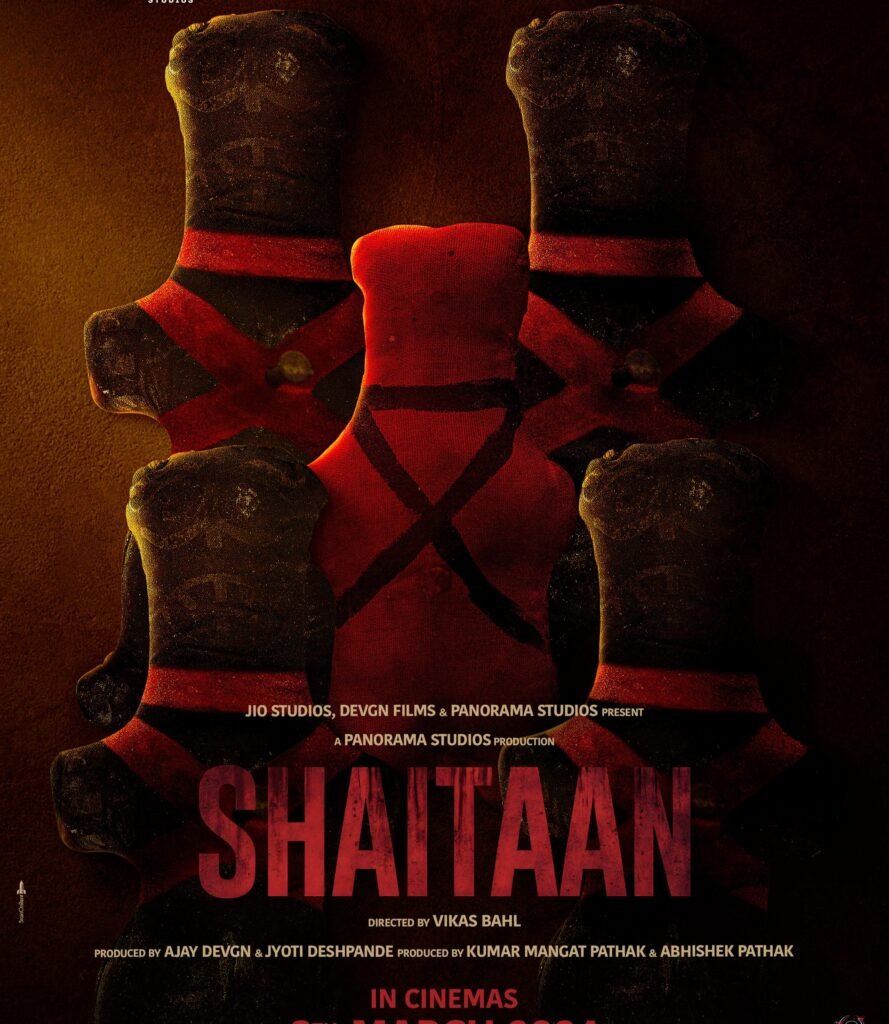
visit now our other review ⚠️🚨⚠️ Fighter Movie :Review Story, Cast, Music, Box Office, OTT, Public

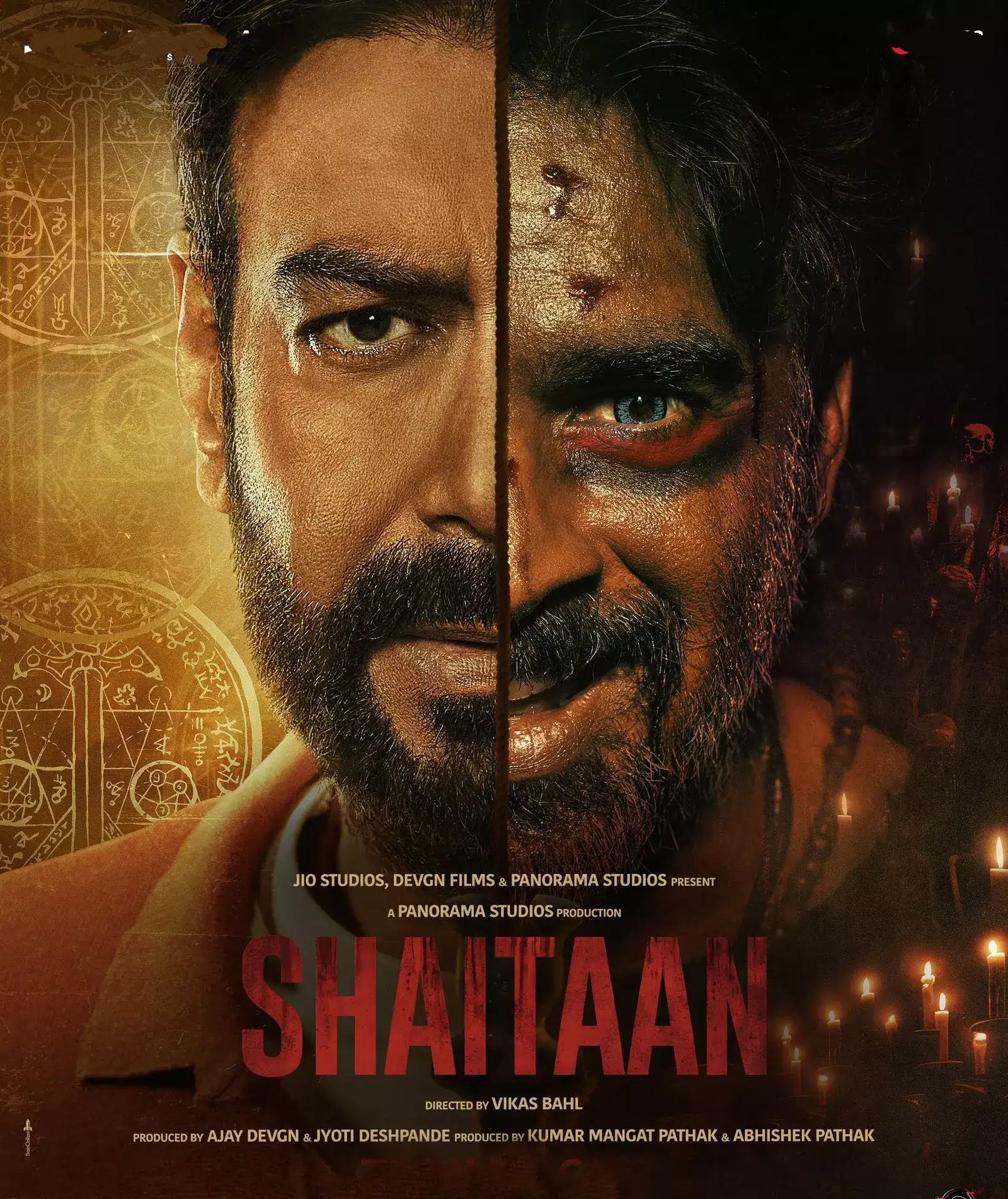
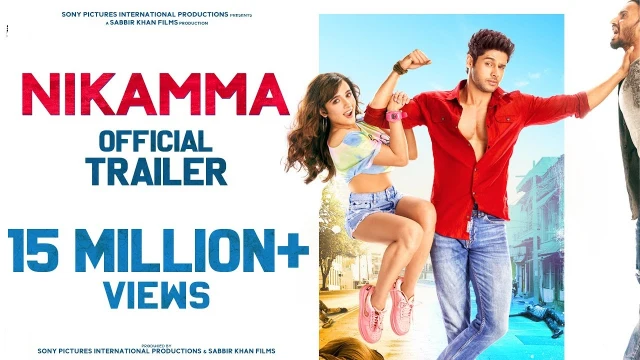

One thought on “Shaitan Movie :Review Ajay Devgn and R. Madhavan’s”